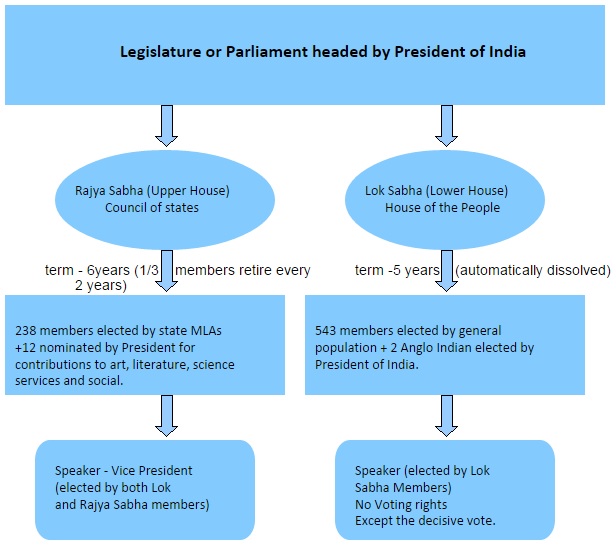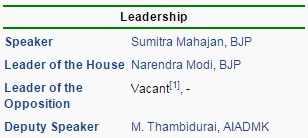In this Article, we will cover the basic aspects of Indian Parliament, its different houses and terms of houses. So carefully read this article and enhance your knowledge about different houses of Indian Parliament.
The Indian Parliament, representing as it does all politically organized shades of public opinion at the national level, holds significantly top and vital position in our nation’s whole constitutional structure. Over the years, Indian Parliament has created for itself a very unique place in the form of honour and respect in the minds of people. It acts as a forum through which people present their problems and get it solved and so they get aspiration to succeed.

Indian Parliament is the highest Authoritative legislative body in India. Our Constitution allows for a bicameral parliament which consists of:
- The President of India
- Lok Sabha (House of the people)
- Rajya Sabha (Council of States)
Terms of Houses of Parliament in India:
1. The President of India
The President of India is the head of the state and is also the first citizen of India. The president heads the Legislature or the Indian Parliament. The President of India is elected indirectly by the people of India from a group of nominees, by the elected members of the Parliament of India (Lok Sabha and Rajya Sabha) as well as of the state legislatures, and holds his/her office for a term of five years.
 The President of India is the formal head of the executive, legislature and judiciary of India and is the commander-in-chief of the Indian Armed Forces. The current existing president is Mr. Pranab Mukherjee. The President of India lives in Rashtrapati Bhavan situated in New Delhi. The tenure for current president is 25/07/2012 to 24/07/2017.
The President of India is the formal head of the executive, legislature and judiciary of India and is the commander-in-chief of the Indian Armed Forces. The current existing president is Mr. Pranab Mukherjee. The President of India lives in Rashtrapati Bhavan situated in New Delhi. The tenure for current president is 25/07/2012 to 24/07/2017.
As per the Article 58, the basic eligibility criteria for becoming The President of India are:
- He/she must be a citizen of India
- Must be over 34 years of age
- Must be qualified as member of Lok Sabha.
Any person who commands any office of profit under the Government of India or the Government of any State or under any local or other authority subject to the control of any of the said Governments shall not be eligible to contest for Presidential post.
However there are some relaxation, where certain office holders are allowed to contest for Presidential Post. They are:
- The current Vice President of India.
- The Governor of any State of India.
- A Union Minister or of any State (Including Prime Minister and Chief Ministers).
In case of selection of the Vice President, State Governor or a Minister for the post of President of India, they are assumed to have relieved from the duty of their last post from the date they start serving as President of India.
The President of India receives current salary amount of ₹1.5 lakh, which was increased to ₹50,000 in the year 1998.
The President can be removed from his post through the process known as impeachment, even before the expiry of his term for violating the Constitution of India. The process may start in either of the two houses of the Indian Parliament. The house begins the process by leveling the charges against the President. These charges are in the form of notice which needs to be signed by at least one quarter of the total members of that house. The notice is sent up to the President and 14 days later, it is taken up for consideration.
A resolution to impeach the President has to be passed by a special majority (two-third majority of the total number of members of the originating house). It is then sent to the other house. The other house investigates the charges that have been made. The President has the right to defend oneself through an authorized counsel during the whole process. If the second house also approves the charges made by special majority again, the President stands impeached and is deemed to have vacated his/her office from the date when such a resolution stands passed. The President cannot be made to vacate his/her office other than the process of impeachment, for the violation of the Constitution.
2. Rajya Sabha
Rajya Sabha or council of States also known as the Upper house of Indian Parliament. The Rajya Sabha has the limitation of only 250 members. Of the total 250 members, 12 are nominated by the President of India someone who possesses special knowledge or practical experience in different fields like literature, science, art or social service. The leftover positions are filled by the representatives of various States and Union territories in accordance or proportion to the population of that particular State or UT. These representatives are elected by the elected members of the Legislative Assembly of that State in accordance with the system of proportional representation by means of the single transferable vote.
The Vice President of India (currently, Hamid Ansari) is the ex-officio Chairman of the Rajya Sabha, who presides over its sessions. The Deputy Chairman, who is elected from amongst the RS’s members, takes care of the day-to-day matters of the house in the absence of the Chairman. The Rajya Sabha held its first sitting on 13 May 1952. The salary and other benefits for a member of Rajya Sabha are same as for a member of Lok Sabha.
It is a permanent body and is not subject to dissolution. The terms of houses of Rajya Sabha for its individual member is six years with one third member retires every two years.
As per Article 84, the eligibility criteria to become a member of Rajya Sabha are:
- He/she must be the citizens of India
- Make and subscribe before some person authorized in that behalf by the Election Commission an oath or affirmation according to the form set out for the purpose in the Third Schedule to the Constitution;
- He/she must be at least 30 years old;
- He/she must possess other qualifications that is formally laid down or imposed on the behalf by or under any law made by Parliament.
- He/she must be elected by the Legislative Assembly of their own States and Union territories by means of Single Transferable Vote through Proportional Representation.
Please click here to know more about Rajya Sabha and its seat distribution among all the states.
3. Lok Sabha
Lok Sabha or House of the People also known as the Lower house of Indian Parliament. The Lok Sabha is composed of representatives of the people chosen by direct election on the basis of voting done by general public. The maximum strength of the House that is limited by the Constitution of India is 552: Out of these 552, not more than 530 members are allowed to represent their respective States, while up to 20 members can represent their respective Union territories and not more than two members are allowed of the Anglo-Indian community to be nominated by the President of India if the President think that the representatives of that community are not adequate enough in the house.
The terms of houses of Lok Sabha, unless sooner dissolved, continues for five years from the date appointed for its first meeting and the expiration of the period of five years operates as dissolution of the House. However, in case of Emergency period, this tenure can be exceeded by Parliament by law for a period not exceeding one year at a time and not extending in any case beyond a period of six months after the Proclamation has ceased to operate. The present number of members in Lok Sabha is 545 which include two nominated members by the President.
As per Article 84, the eligibility criteria to become a member of Lok Sabha are:
- He/she should be a citizen of India, and must subscribe before the Election Commission of India an oath or affirmation according to the form set out for the purpose in the Third Schedule of Indian Constitution
- He/She, must be of the age of 25 years or older.
- He/she possesses other qualifications that is formally laid down or imposed on the behalf by or under any law made by Parliament.
- He/she should not be involved in any criminal cases or ever convicted by law.
- He/she should have his/her name in the electoral rolls in any part of the country.
A member can be disqualified of being a Member of Lok Sabha:-
- If he/she holds any office of profit;
- If he/she is in not good mental condition and stands so declared by a competent court;
- If he/she is not able to discharge his duty;
- If he/she is not a citizen of India, or has voluntarily acquired the citizenship of a foreign State;
- If he/she is violating party discipline (as per Tenth schedule of the constitution); disqualified under Representation of People Act.
Furthermore, as per article 101, a person cannot be:-
- A member of both the Houses of Indian Parliament simultaneously and provision shall be made by Parliament by law for vacating his seat in one house or the other.
- A member of both the houses of Parliament and of a House of the Legislature of a State.
For the purpose of holding direct elections to Lok Sabha; each state is divided into territorial constituencies. In this respect, the constitution of India makes the following two provisions:
- Each state has pre-allotted a definite number of seats in the Lok Sabha in accordance and proportion to its population so that the ratio is same for all the states of India. This provision is not applicable for states having less than 60 lakhs population.
- Each state is divided into territorial constituencies in such a manner that the ratio between the population of each constituency and the number of seats allotted to it remain the same throughout the state.
Please click here to know more about Lok Sabha and its seat distribution among all the states.
There are some facts about our Indian Parliament. Please click this link to visit the website to know more.

here mentioned president also formal head of Judiciary….